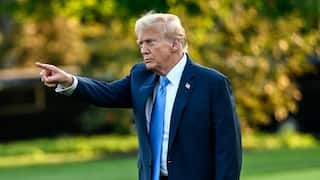Before Trump, 4 Ex-Presidents Ran Again For The US Top Post. Only One Won
Former US President Donald Trump has announced that he will seek the Republic Party nomination to contest in the 2024 presidential election.

Former United States President Donald Trump has announced that he will seek the Republic Party nomination to contest the 2024 presidential election. Trump's move will be something that has been rarely seen in America's political history. He will join a short list of candidates who made a re-attempt at presidency.
Here is the list of former US presidents who made attempts to come back to power:
Martin Van Buren
Known as the father of the American party system, Martin Van Buren was one of the founding members of the Democratic Party. He was an American lawyer and statesman who served as the eighth US president from 1837 to 1841. In the year 1837, the United States suffered a financial panic just as Van Buren ascended to the presidency. Like Trump, who faced a pandemic, Van Buren took office just in time for a full-fledged financial panic, which triggered a deeper recession. In 1840, Van Buren lost his re-election bid against William Henry Harrison, who was a member of the Whig Party.
In the 1948 elections, he got just 10 percent of the vote and likely helped throw the presidential election to Zachary Taylor. It was his last attempt at politics.
Grover Cleveland
Since 1856, Grover Cleveland was the first Democrat to be elected president in 1884. He was not at the center of bruising political battles over Reconstruction. After a quarter-century of strife over slavery and sectionalism, the American voters were ready to give him a shot. With the South in solid Democratic control and New England favoring Republicans, Cleveland narrowly defeated James G. Blaine.
He ran again in 1888 and lost the election. Cleveland ran a fairly lackluster campaign in 1892. He won the election majorly because of the tight electoral map. The electorate was sharply polarised, with just a small number of swing voters in a handful of swing states likely to shift the balance in either direction.
Theodore Roosevelt
Roosevelt proved an uncommonly successful president during his seven years in office. His achievements were far ranging from protecting the environment and establishing national parks to bringing railroads and large industrial trusts to heel. He committed one of the worst blunders in presidential history. After his election in 1904, he announced that he will seek a third term. It was a decision he regretted later.
In 1909 he stepped aside and made way for his hand-picked successor, William Howard Taft. Roosevelt traveled to Africa for a year-long hunting excursion and returned in 1910 only to see that Taft had seemingly allied himself with conservative Republicans.
Later Roosevelt and his progressive supporters formed the new Bull Moose Party, which supported many of the social and political reforms TR had embraced as president. Republicans divided, and the Democrat, Woodrow Wilson won and became the president in 1913. Roosevelt had the distinction of being the only third-party candidate to outpoll the nominee of a major political party- he was placed second, with Taft a distant third.
Herbert Hoover
Hoover, an engineer and millionaire, served as the head of the Commission for Relief in Belgium during World War I and later went on to become the director general of the American Relief Administration in Europe. He won accolades for these roles. Hoover was elected president of the United States in 1929. The Great Depression severely damaged Hoover’s reputation. It came to be known as the “Hoover Depression.”
In 1940, Hoover made a concerted effort to win the Republican nomination but GOP leaders were reluctant to look backward. They turned instead to businessman Wendell Willkie, a progressive and internationalist who ran a credible but losing race against FDR. It was the last time a defeated president made an attempt at a comeback.
Related Video
Vande Bharat: India’s First Vande Bharat Sleeper Train to Run Between Guwahati and Kolkata





































